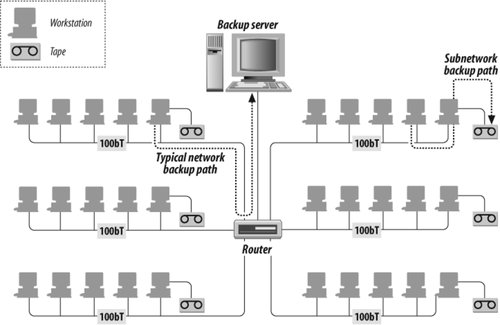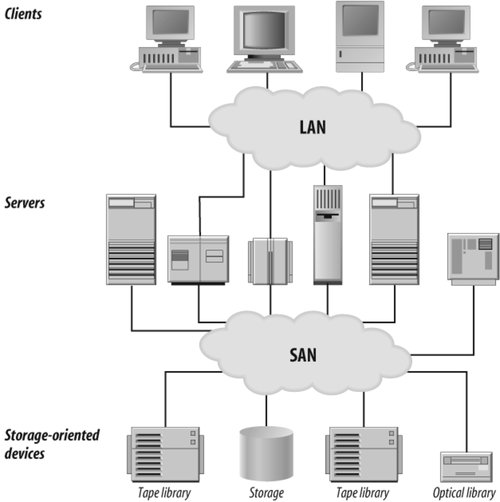Section 8.11. Reduction in Network Traffic
8.11. Reduction in Network TrafficOne of the best ways to perform backups is to install a completely separate network to carry all the backup traffic. However, many people do not have the funding necessary to set up such a network, so they need to be careful about how their backup system influences the network that it shares. There are a few different things that backup products can do to minimize their impact on the network, whether it is a private one for backups or the corporate backbone. 8.11.1. Keep Backup Traffic at the Subnet LevelOne of the best ways for a backup product to reduce the amount of traffic that goes between networks is to distribute the backup devices to the subnet level. Keeping backup traffic on its local subnet results in two benefits. First, backup traffic is distributed, so that no single subnet sees all the traffic. The overall impact to the internal customer (who also is trying to use the corporate intranet) is therefore reduced. The second benefit is that the overall throughput of the backup system will be able to scale with the network as the network grows by the addition of subnets. Consider the drawing in Figure 8-4. There are six different subnets (100.10100.15), each of which is switched 10 MB (switches not shown). Each of the switches is plugged into a router, which also is plugged into the 100.1 subnet, where the backup server resides. Figure 8-4. Network backup data paths A typical, network-based backup system causes data to flow in the manner illustrated by the data path on the left. The data path represented by the left-side dotted line shows that the data goes over the 100.10 subnet, the router, and the 100.1 subnet to the backup server. If all six subnets are backed up that way, the total backup throughput could be no higher than the speed of the 100.1 subnet or the router because all traffic must go through them. The result is that the backup system never streams the backup drive. However, if the backup software supports remote devices, the backup traffic can be localized to the subnets, as illustrated on the right. Even without taking advantage of switching technologies, the backup system now has an overall throughput of 6 MB/s instead of 1 MB/s. 8.11.2. Use Client-Side CompressionBackup software products also can use client-side compression to reduce network traffic. This means that files are compressed on the client before they are sent across the network. This is very CPU-intensive on the client end, but the amount of data that actually goes out on the network can be greatly reduced. If the system CPUs are fast and the network is slow, this can improve overall backup throughput and reduce total backup time.
8.11.3. Incorporate ThrottlingAnother feature that is difficult to find in backup software products is called throt tling and can help reduce the effect of the backup traffic on the overall network. Some products allow the administrator to throttle a backup client, that is, to specify how many megabits per second a backup client can send out on the network. That way, even on a 100 Mb network, the backup system would use only a prescribed percentage of the total bandwidth, since that's what it was told to do. This slows down the backups, of course, but the people trying to use the network will surely appreciate it. 8.11.4. Storage Area NetworksStorage area networks, as shown in Figure 8-5, present several advantages when used with a backup system. A SAN:
Figure 8-5. Connecting any type of peripheral via a SAN When considering SAN technology in light of the backup and recovery industry, it is the ultimate network traffic-reduction method. It allows SAN-connected hosts to perform LAN-free backups (see the section "LAN-Free Backup" earlier in this chapter), taking advantage of the recent advancements in CPU and memory usage reduction. It does all this while allowing maximum utilization of large libraries. If you have a large environment, and especially if you have very large servers, you definitely should find out which backup applications support LAN-free backups. |
EAN: 2147483647
Pages: 237
